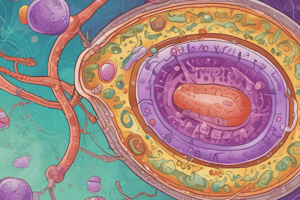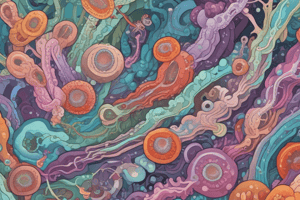Podcast
Questions and Answers
What is the characteristic feature of a gram-positive bacterial cell known as a protoplast?
What is the characteristic feature of a gram-positive bacterial cell known as a protoplast?
- It has a complete peptidoglycan cell wall.
- It has a partially removed cell wall.
- It has a thick outer membrane.
- It is surrounded only by its cell membrane. (correct)
What is the primary difference between a spheroplast and a protoplast?
What is the primary difference between a spheroplast and a protoplast?
- The type of bacterial cell they are derived from.
- The degree of cell wall removal. (correct)
- Their ability to reform a cell wall.
- The presence or absence of the outer membrane.
Which of the following statements is true about L-form bacteria?
Which of the following statements is true about L-form bacteria?
- They have a complete peptidoglycan cell wall.
- They are always spherical in shape.
- They are only derived from gram-negative bacteria.
- They can be either gram-positive or negative. (correct)
What is the common characteristic of protoplasts, spheroplasts, and L-form bacteria?
What is the common characteristic of protoplasts, spheroplasts, and L-form bacteria?
What can cause the formation of L-form bacteria?
What can cause the formation of L-form bacteria?
What is the primary difference between a gram-positive bacterial cell and a spheroplast?
What is the primary difference between a gram-positive bacterial cell and a spheroplast?
Which of the following statements is true about the cell membrane of a protoplast?
Which of the following statements is true about the cell membrane of a protoplast?
What is the characteristic that distinguishes an L-form bacterium from a spheroplast?
What is the characteristic that distinguishes an L-form bacterium from a spheroplast?
Which type of bacterial cell can have either a gram-positive or gram-negative cell wall?
Which type of bacterial cell can have either a gram-positive or gram-negative cell wall?
What is the common result of either a spontaneous mutation or the presence of certain drugs in bacterial cells?
What is the common result of either a spontaneous mutation or the presence of certain drugs in bacterial cells?
Study Notes
Protoplast
- A protoplast is a gram-positive bacterial cell that lacks a cell wall.
- The primary difference between a protoplast and a spheroplast is that a spheroplast is a gram-negative bacterial cell that lacks a cell wall.
L-Form Bacteria
- L-form bacteria are bacteria that have lost their cell wall.
- L-form bacteria can be either gram-positive or gram-negative.
- L-form bacteria can be caused by spontaneous mutation or the presence of certain drugs.
Common Characteristics of Protoplasts, Spheroplasts, and L-form Bacteria
- All three lack a cell wall.
Cell Membrane of a Protoplast
- The cell membrane of a protoplast is the outermost layer of the cell.
Distinguishing Characteristics
- L-form bacteria are distinguished from spheroplasts by their ability to survive and reproduce without a cell wall.
Spontaneous Mutation or Drugs
- Spontaneous mutation or the presence of certain drugs can cause bacterial cells to lose their cell wall and become L-form bacteria.
Studying That Suits You
Use AI to generate personalized quizzes and flashcards to suit your learning preferences.
Description
Learn the differences between protoplast, spheroplast, and L form in bacterial cells. Understand how these forms are created and their characteristics. Useful for microbiology and biology students.




